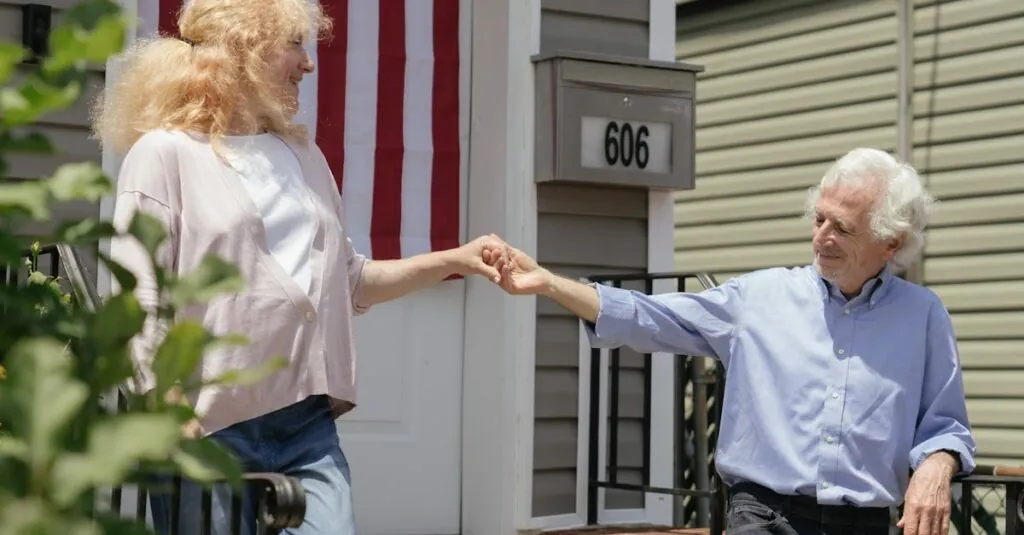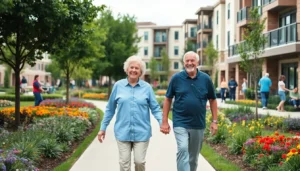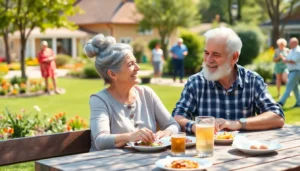As the sun sets on a vibrant life filled with pride, the quest for the perfect retirement haven begins. For many in the LGBTQ+ community, finding a place that embraces their identity while offering comfort and camaraderie can feel like searching for a unicorn in a haystack. But fear not! The world of LGBTQ+ retirement housing is blossoming, offering not just a roof over one’s head but a community that celebrates diversity and love.
Imagine sipping cocktails at a poolside party with neighbors who truly get it, sharing stories that resonate, and living in a space where authenticity reigns supreme. This isn’t just about finding a home; it’s about creating a sanctuary where everyone can thrive. Get ready to explore the colorful options available, because retirement doesn’t mean slowing down—it means living life to the fullest, surrounded by those who understand the journey.
Table of Contents
ToggleUnderstanding LGBTQ+ Retirement Housing
LGBTQ+ retirement housing refers to residential spaces designed specifically for LGBTQ+ individuals or couples in their later years. These living environments prioritize inclusion, acceptance, and support for residents, creating a safe place for self-expression.
Definition and Importance
LGBTQ+ retirement housing encompasses various types of accommodations, including independent living facilities, assisted living communities, and co-housing arrangements. It’s important for these spaces to address unique needs or concerns faced by the LGBTQ+ community. Safety and belonging play crucial roles in the well-being of residents. By offering a supportive atmosphere, LGBTQ+ retirement housing nurtures strong connections among residents, leading to enhanced mental health, emotional stability, and overall happiness.
History of LGBTQ+ Housing Needs
Historically, LGBTQ+ individuals faced discrimination in housing and healthcare, leaving many without adequate support as they aged. The lack of options prompted the creation of LGBTQ+ retirement communities that cater specifically to this demographic. In the late 20th century, the AIDS crisis highlighted the need for safe and welcoming spaces for older LGBTQ+ adults. Since then, awareness around the importance of inclusive housing has grown. Recent statistics indicate a steady increase in LGBTQ+ retirement communities. Reports show that nearly 1 in 10 LGBTQ+ adults over 50 lives in an LGBTQ+ friendly setting, reflecting a positive shift toward acceptance and support in retirement planning.
Challenges Faced by LGBTQ+ Seniors
LGBTQ+ seniors encounter several challenges that affect their retirement living experience. Discrimination remains a significant issue for many, often stemming from outdated stereotypes and societal stigma.
Discrimination and Stigma
Discrimination occurs in various forms, including housing policies and personal biases. Aging LGBTQ+ individuals may face rejection when seeking housing, especially from traditional facilities not equipped to support their identities. Stigma surrounding sexual orientation and gender identity often leads to feelings of isolation and anxiety in communal living environments. Many LGBTQ+ seniors prefer to seek out communities that offer acceptance and understanding, creating safe spaces for themselves. Data shows this desire for safer housing options continues to grow. Safe and inclusive environments make a considerable difference in their overall quality of life.
Access to Healthcare and Services
Accessing healthcare services poses challenges for LGBTQ+ seniors, particularly concerning sensitive issues related to sexual orientation and gender identity. Many healthcare providers lack proper training on LGBTQ+ health needs, leading to inadequate care. Fear of discrimination can prevent seniors from seeking necessary medical assistance. Moreover, finding culturally competent healthcare providers remains difficult, especially in rural areas. Statistics indicate that nearly one in five LGBTQ+ adults ages 50 and older experiences barriers to accessing healthcare. Equal access to care and services directly influences the health and well-being of LGBTQ+ seniors.
Types of LGBTQ+ Retirement Housing
LGBTQ+ retirement housing options vary significantly to cater to diverse needs. Each type of accommodation provides unique benefits tailored to enhance quality of life for seniors.
Independent Living Communities
Independent living communities offer LGBTQ+ seniors a vibrant atmosphere emphasizing autonomy. Residents enjoy private living spaces while engaging in social activities that foster friendship and connection. These communities typically organize events such as game nights and art classes, promoting interaction among residents. Many facilities prioritize inclusivity, making it easier for LGBTQ+ individuals to live authentically. Statistics indicate that nearly 1 in 10 LGBTQ+ adults over 50 reside in these friendly settings, reflecting a growing trend towards acceptance in retirement living.
Assisted Living Facilities
Assisted living facilities cater to those who require additional support while valuing independence. Staff members are trained to address the specific needs of LGBTQ+ seniors, ensuring a respectful and affirming environment. Services often include assistance with daily living activities, such as meal preparation and medication management. Additionally, many facilities encourage socialization through group activities and outings, creating a sense of community. With the rising demand for these accommodations, it’s essential to choose a facility that prioritizes inclusivity and support for its residents, addressing the unique challenges LGBTQ+ seniors face.
Benefits of LGBTQ+ Retirement Housing
LGBTQ+ retirement housing offers numerous advantages that enhance the quality of life for seniors. These spaces foster an environment of acceptance and belonging, specifically tailored to meet the needs of the LGBTQ+ community.
Inclusive Community and Social Support
Inclusive communities empower LGBTQ+ seniors to engage in supportive relationships. Residents share experiences and participate in activities that celebrate their identities. Friendships flourish in a space where individuals feel understood and safe. Social support systems combat isolation, fostering a strong network among residents. Living among peers who share similar backgrounds encourages open communication and connection. Activities often include group outings, art classes, and discussion groups that promote mental well-being.
Tailored Services for Seniors
Tailored services cater to the unique needs of LGBTQ+ seniors within retirement housing. Care staff receive specialized training to understand LGBTQ+ health concerns and sensitivities. By prioritizing inclusive practices, facilities create a respectful atmosphere for all residents. Access to healthcare resources meets the specific requirements of the community. Flexible service options ensure seniors receive assistance based on individual needs. Housing environments are designed to address mental and physical health, enhancing overall well-being. Options may include wellness programs, counseling services, and healthcare navigation assistance.
Notable LGBTQ+ Retirement Housing Developments
Numerous LGBTQ+ retirement housing developments create inclusive and supportive environments for seniors. These communities not only provide safe shelter but also foster connection and camaraderie among residents.
Case Studies of Successful Communities
The Rainbow Village in Florida stands as a model for LGBTQ+ retirement living, featuring independent living units designed for an active lifestyle. Residents enjoy amenities such as a pool, fitness center, and community gardens, promoting engagement. Another example is the New York City-based Stonewall House, which combines affordable housing with supportive services tailored to LGBTQ+ seniors. This community emphasizes social interaction through organized events and activities, addressing the need for companionship among residents.
Innovations in Design and Services
Innovations in LGBTQ+ retirement housing focus on creating welcoming spaces. Design elements such as gender-neutral restrooms and communal areas encourage inclusivity. Specialized services, including mental health support and wellness programs, cater to the unique needs of LGBTQ+ seniors. Facilities often employ staff trained in LGBTQ+ issues, ensuring respectful and affirming interactions. These advancements enhance the overall quality of life for residents, making the retirement experience more vibrant and fulfilling.
Conclusion
The search for LGBTQ+ retirement housing marks a significant step toward creating inclusive spaces where seniors can thrive. As more communities recognize the unique needs of LGBTQ+ individuals, the options for vibrant living continue to expand. These dedicated environments not only provide safety and support but also foster connections that combat isolation.
With tailored services and a focus on acceptance, LGBTQ+ retirement housing enhances the overall quality of life for its residents. As acceptance grows within society, so does the opportunity for LGBTQ+ seniors to enjoy fulfilling and authentic retirement experiences. Embracing these changes is essential for a future where everyone can live freely and joyfully in their golden years.








